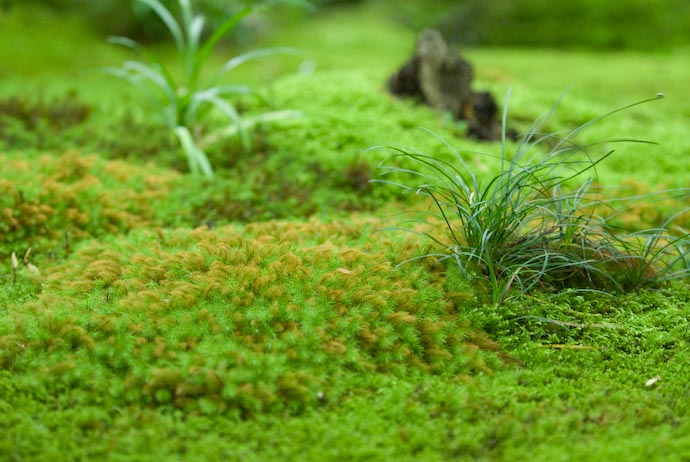
Nikon D200 + Nikkor 70-200mm f/2.8 @ 70mm — 1/30 sec, f/2.8, ISO 800 — map & image data — nearby photos
Lots of Moss at the Giouji Temple
After one of my posts about a recent visit to the Nanzenji Temple, my mom mentioned in a comment that one of her books on moss gardening mentions a Giouji Temple in Kyoto for its nice mossy scenes (and I realize today that you can see at Amazon that the back cover features a photo from the temple).
So today, I headed across the city to the far western edge of Kyoto to visit the Giouji Temple (祇王寺 — pronounced with three distinct syllables: “gi” with a hard G, an “ou” (which makes a lengthed “o” sound like in the English “boat”), and a final “ji”).
It's not even really a temple, but more of a little hermitage, as the supplied English pamphlet notes. There's only one small building with a few partitions, appropriate perhaps for meditation or having some tea, but not big enough for much else. All in all, it's all about the gardens, which are superb.
Whatever it is, I'm extremely enamored with it. It's my new favorite garden, and my new favorite secret of Kyoto. It's way off the beaten path... it's quite, supremely serene, and uncrowded (no bus loads of tourists will show up; compare with the last photo in this Kiyomizu Temple post). It's very small, but having spent more than an hour enjoying and taking pictures, there are still sections that I didn't get to.
Of the photos I took, I have 133 “keepers,” most of which I want to share here on my blog. Today's post is just an introduction to the grounds; subsequent posts will concentrate on the mosses (some 18 different types), the small hermitage, a few photogenic snails, two different posts on the wall architectures (short walls and tall walls), and probably a few other things.
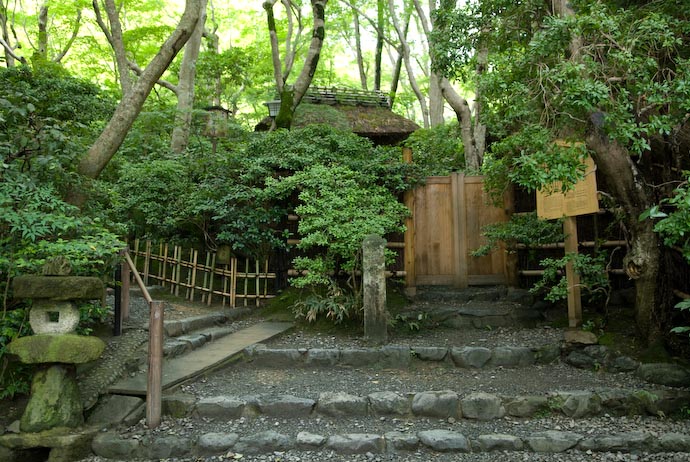
Nikon D200 + Nikkor 17-55 f/2.8 @ 23mm — 1/40 sec, f/2.8, ISO 400 — map & image data — nearby photos
Giouji as Seen From the Street
Up a few steps, turn left, and you have this long entrance path...
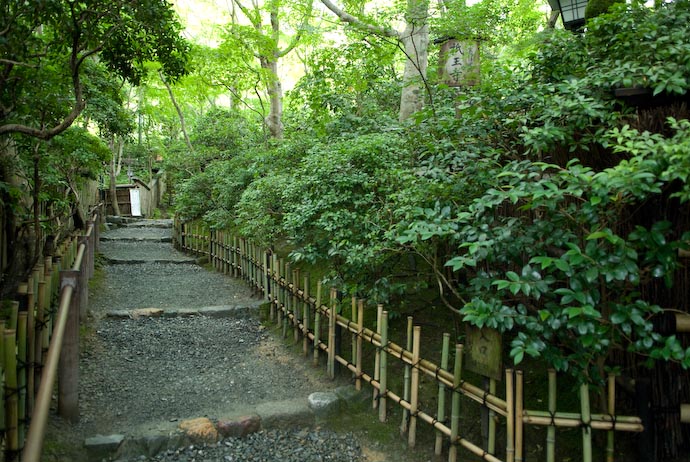
Nikon D200 + Nikkor 17-55 f/2.8 @ 18mm — 1/50 sec, f/2.8, ISO 640 — map & image data — nearby photos
Path up to the Entrance
Up and around the corner to the right, you see the entrance gate (left in the photo below) and the posting of entrance fees on the wall: 100 yen for elementary school kids, 300 yen for middle-school kids, 300 yen for high-school kids, and 300 yen for adults; that's about 80 cents and $2.50, respectively.
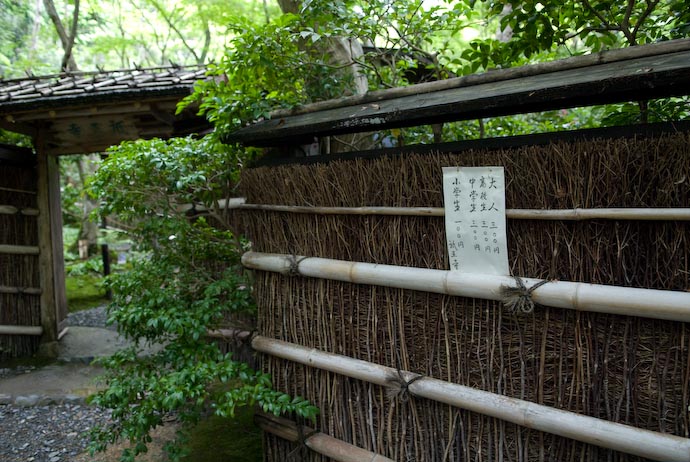
Nikon D200 + Nikkor 17-55 f/2.8 @ 18mm — 1/60 sec, f/2.8, ISO 640 — map & image data — nearby photos
Entrance
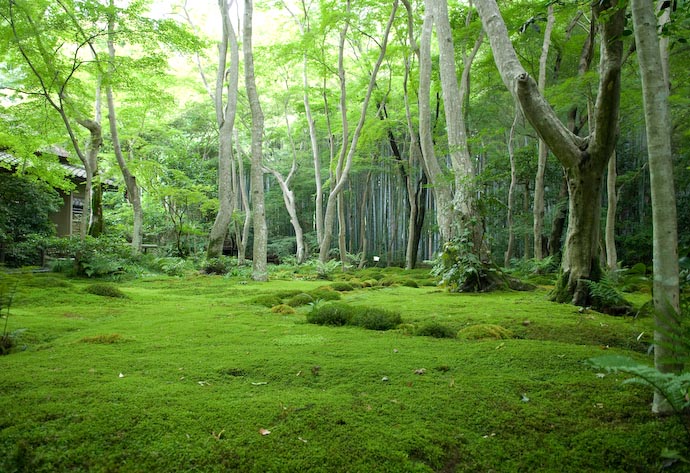
Nikon D200 + Nikkor 17-55 f/2.8 @ 17mm — 1/40 sec, f/2.8, ISO 800 — map & image data — nearby photos
Main Garden
The entire grounds are really quite small, so the main garden area and the path that goes around it are, of course, even smaller. Yet, even within the small area there are many sections that have their own distinct look and atmosphere, and each presents a different face as you walk around, so by the time you get around, it feels as if you've covered a few miles of wonderful variety. It's amazing and defies all explanation..
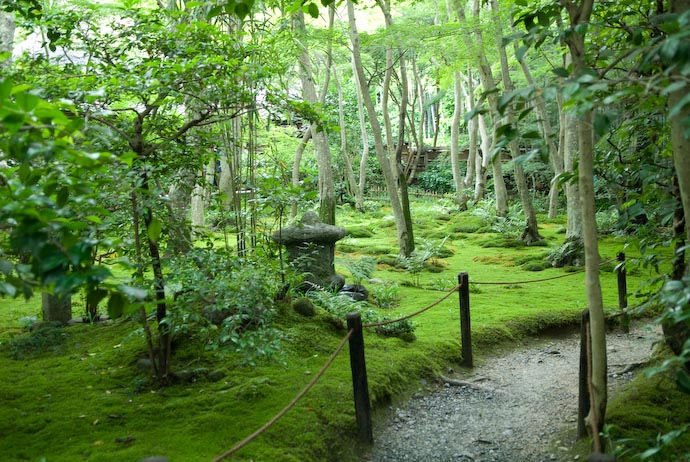
Nikon D200 + Nikkor 17-55 f/2.8 @ 26mm — 1/40 sec, f/2.8, ISO 800 — map & image data — nearby photos
Around One Corner...
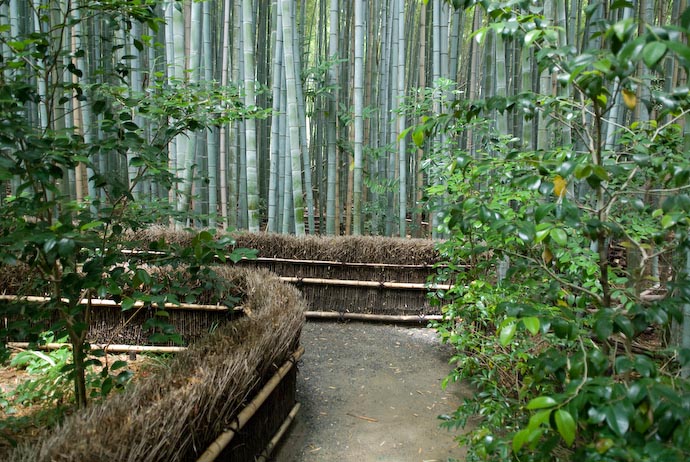
Nikon D200 + Nikkor 17-55 f/2.8 @ 17mm — 1/100 sec, f/2.8, ISO 800 — map & image data — nearby photos
...To Another.
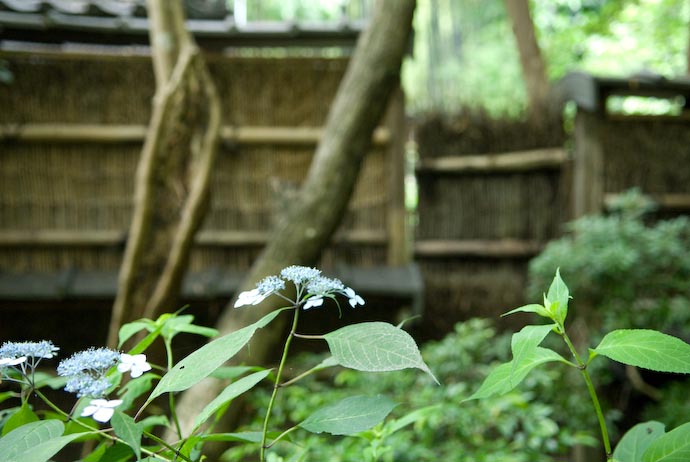
Nikon D200 + Nikkor 17-55 f/2.8 @ 31mm — 1/80 sec, f/2.8, ISO 800 — map & image data — nearby photos
Occasionally, Other Colors as Well
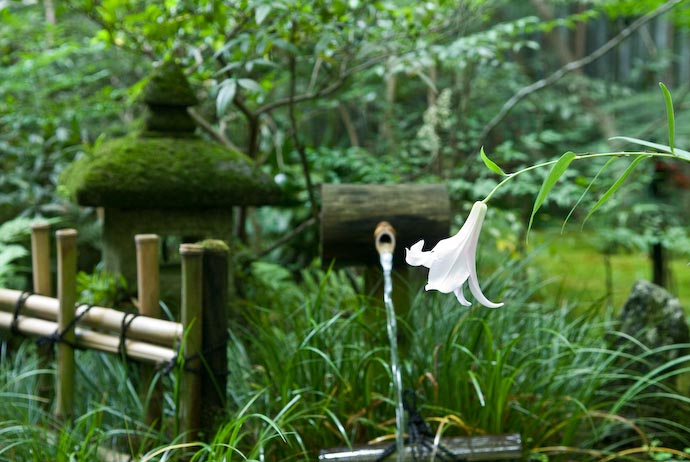
Nikon D200 + Nikkor 17-55 f/2.8 @ 35mm — 1/80 sec, f/4, ISO 800, — map & image data — nearby photos
Stone Lantern and Other Garden Features
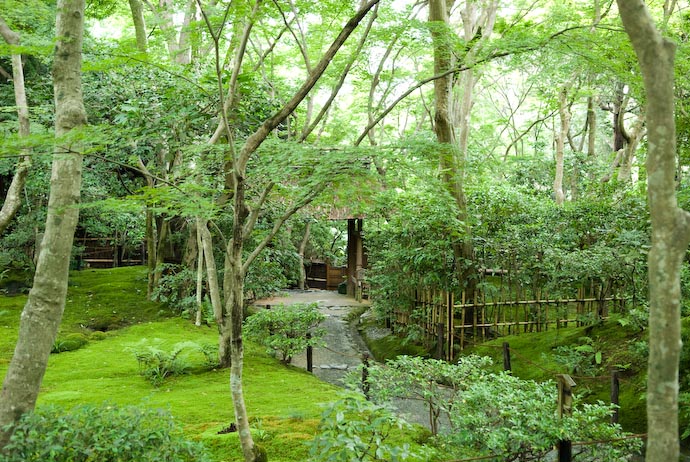
Nikon D200 + Nikkor 17-55 f/2.8 @ 30mm — 1/60 sec, f/2.8, ISO 800 — map & image data — nearby photos
Formal Entrance Gate
It's perhaps difficult to see in the shot above, but in the middle is a gate with a large thatched roof. The path around the main garden goes through this, but turns to follow the garden. However, a wider path leads down to a door in the fence, opened, I'd speculate, only for VIPs and the occasional visiting landscaper. You can see the gate and the thatched roof in the second image of this post (“Giouji as Seen From the Street”)
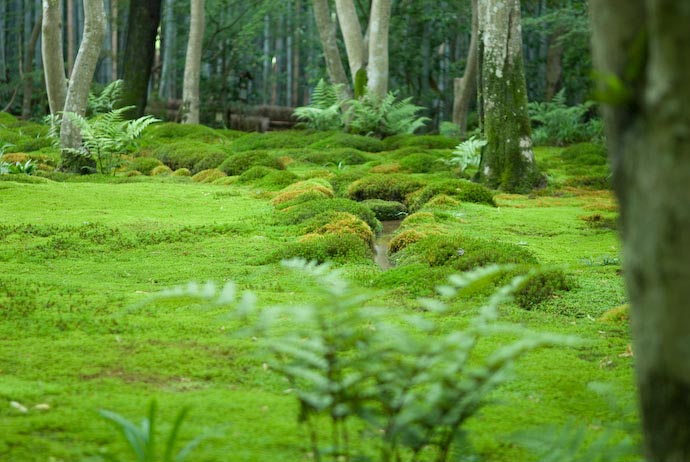
Nikon D200 + Nikkor 17-55 f/2.8 @ 55mm — 1/40 sec, f/2.8, ISO 640 — map & image data — nearby photos
The Smallest of Streams
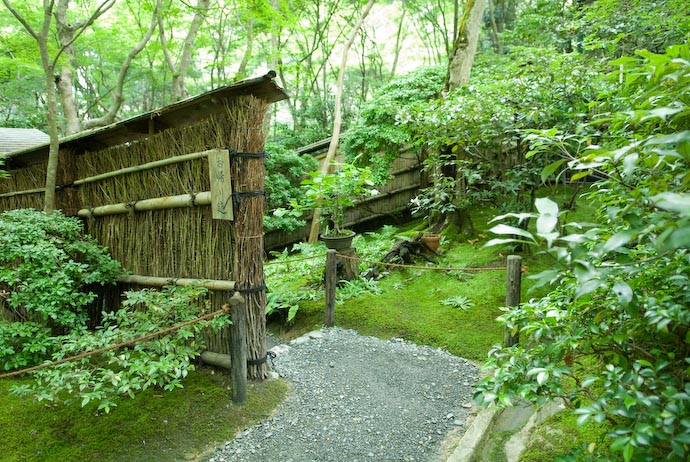
Nikon D200 + Nikkor 17-55 f/2.8 @ 18mm — 1/50 sec, f/2.8, ISO 800 — map & image data — nearby photos
Exit Path
Everything about this place exudes serenity. The design, the gardening, the architecture.... it's all of the highest caliber. It's not the kind of fancy superficial “high class” you find at stuffy five-star hotels, but the result of what one extremely skilled person might produce for herself during a lifetime of devotion (which is apparently what happened: the site has been a temple or nunnery or something for most of the last thousand years, but it exists in its present state mostly due to the work of a former Geisha, “Chishoni,” who passed away in 1994).
Everything is simple and understated, letting nature do the talking. All the construction materials are natural, and much of it is rotting or otherwise going back to nature to some extent or another, to be replaced only when it can no longer serve its function. The walls, fences, paths, signs, and such are as much part of the garden as the mosses.
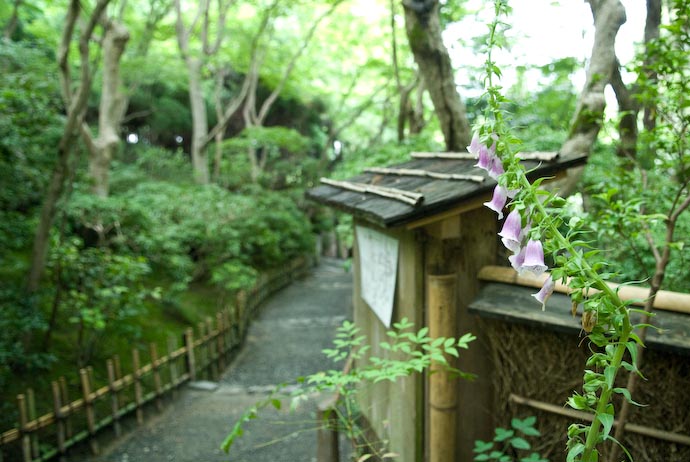
Nikon D200 + Nikkor 17-55 f/2.8 @ 17mm — 1/90 sec, f/2.8, ISO 800 — map & image data — nearby photos
Looking Back Down the Entrance Path
As can be seen in the photo above, along the path leading to the entrance is a small wood and bamboo display. It holds a hand-drawn map of the area, highlighting the path to other temples and public transport.
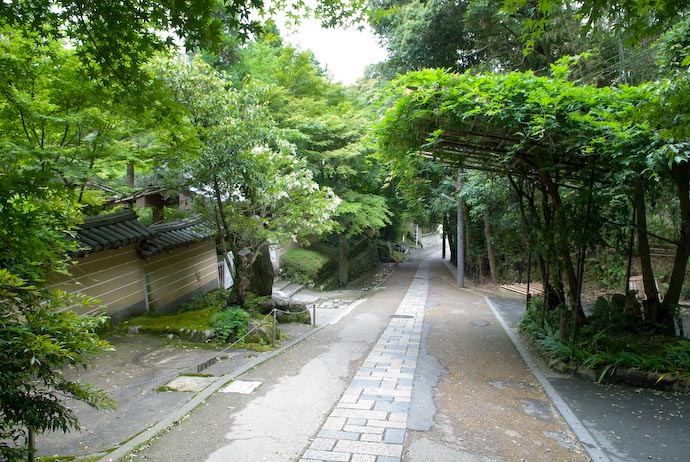
Nikon D200 + Nikkor 17-55 f/2.8 @ 17mm — 1/160 sec, f/6.3, ISO 800 — map & image data — nearby photos
Looking Out at the Street
What looks like a path in the shot above is the public street, which dead-ends at the temple. The wall at left is unrelated to the temple; at right is a small parking and turn-around area.
I was the only visitor for much of the time during the hour I was there. At various times pairs of elderly Japanese would walk through with their taxi driver, and at one point a dozen or so extremely well behaved middle-school kids came through. But for the most part, it was my garden.
Sometimes I feel as if the camera is something that separates me from the things I photograph (Anthony playing, visiting a famous spot, etc.), but in this case the camera helped me to slow down and appreciate at a much finer level of detail. A few years ago I would have walked in, thought it was wonderful as I strolled around, and been gone after 10 minutes. Now, I enjoy every detail, and appreciate the small touches that I didn't even notice before.
I can't wait to go back again, preferably with Fumie. It's also supposed to be breathtaking in the fall, so that's on my list, too.
Interestingly enough, I'd headed over to Western Kyoto with the intention to visit Saihouji, also known as Kokedera, “The Moss Temple.” I thought to stop by the tiny Giouji just so I could tell my mom that I did, but what I found was so wonderful that I ran out of time to continue on to the moss temple.
I was thrilled enough with what I found at Giouji, but this evening while writing this post, I found that I was even luckier than I had thought, for it turns out that to visit the Moss Temple, one must pre-apply for a visit by postcard at least a week in advance, and once granted, must pay a fee 10× that of Giouji and perform a couple of hours worth of zen stuff (meditation, chanting, copying sutras, etc.) before being allowed in. Doh! I'll pass.
So, double-thanks for the tip, Mom!
Wow that very beautiful!!
Here is the official site – sorry Japanese only
http://www.giouji.or.jp/
more pics from flickr.com
http://www.flickr.com/search/?q=%E7%A5%87%E7%8E%8B%E5%AF%BA&w=all&s=int
Glad you liked it, dear. It is certainly charming and the serenity of it belies the amount of work involved. Yet the work on it is in itself relaxing,as redundant as that sounds.
I know,because on a more minute scale, many years ago I was working on the mossy creek banks in the woods down past the dam. It started as a little 3 x 3 foot area of moss I discovered ( just where you helped me build that little waterfall). I was charmed by the effect, and kept the leaves off and the weeds out, enlarging the area gradually until eventually the whole long walk and creekbank became covered in the moss. It was such a perfect spot for birdwatching.( I’ve neglected it of late since I now do most birdwatching on the veranda or in the arbor. )
But in Japan, those beautiful moss gardens are kept free of leaves and debris by somebody, probably in off-hours.
There was a lady on her hands an knees with a small hand-made brush working diligently with no discernible effect, so that’s probably what you’re talking about. She was in one of the sections I didn’t get to this time.
As delicate as moss appears, much of it can be walked on occasionally with little effect. And it can be encouraged to grow on things like rocks and cement by mixing some moss in a blender with a little yogurt or mayonnaise and painting it on the damp object. Maybe you could remake your parking lot into a little Japanese garden of your own. Start out with planting a few trees (Moss loves shade), take some classes in Wattle and Daub, learn to make hypertufa lanterns, (or I can show you when you come this summer ) form a little trickling recirculating rockstrewn stream with a comfortable bench beside it, and in a very few years you and the neighborhood birds could have your own private little retreat. And you might find it addicting to putter in it. (Not to mention the pleasure of photographing it every step of the way)
I don’t really have much of a green thumb… planting a moss garden myself as about as much appeal as, er, watching moss grow. 🙂 —Jeffy
Just wish I’d known of Giouji during my too-long-ago visits to Kyoto: it looks exactly my sort of place.
Grandma Friedl’s comments are right on the ball, and make me feel that _I_ should have a go at a small moss garden here in wet Wales. And I really must buy myself the Schenk moss gardening book that she mentioned.
Thanks for a lovely post.
Peter
Wish this Giouji Temple had been on our tour excursion itinerary a few weeks ago!
Shimada’s official Japanese site link is interesting also.
Aunt Jeannette
Beautiful pictures, wonderful setting, I’m in Brazil and this scenery is very exotic to me (as much as our forests would be to a Japanese, I guess).
Question: which RAW suite do you use mostly?
I will be in Kyoto for a few days and after seeing your pictures I’d love to see this garden!
What’s the best way to reach it with JR trains? I can make heads nor tails out of http://www.giouji.or.jp/acc/index.html 🙂
Thanks!
Wout.
The nearest JR station is Saga-arashiyama, the sixth station north-west of Kyoto on the Sagano-sen. Gioji is about a mile’s walk from there. (Each picture on my post has a map link, so you can see where Gioji is on a real map). It’d be a pleasant walk if you don’t get lost, and if you have the time, it’d be pleasant even if you did. I would expect that taxi drivers would know where it is, although it wouldn’t hurt to bring a copy of the map with you. Enjoy! —Jeffrey